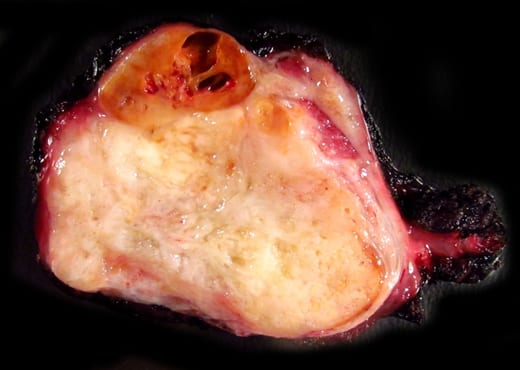Auto Text: “Insert Soft Tissue Oriented” or “Soft Tissue Unoriented”
Triage
- Take photographs of all resections in the intact (and later, cut) state.
- Weigh and measure in 3-dimensions.
- Measure skin and associated scar, if applicable.
- In order to evaluate margins:
- Examine the outer surface/capsule for anatomic structures (nerves, bone, skin, vasculature).
- Ink the resection margin: The outer surface can be friable / moveable, so make sure the ink is on a true margin (ask an attending for help if unsure). If unoriented, use 1 color. If oriented, two or more colors can be used as discussed with attending.
- Some pediatric neuroblastomas come labeled as soft tissue resections – please see the Neuroblastoma page in the Peds section.
- Serially section the specimen in 0.5 – 1.0 cm increments. Do NOT maintain “bookends” – please section completely. If you fear loss of orientations, slices can be re-approximated and wrapped in paper or gauze.
- Photograph representative cut-section(s).
- Measure the size of tumor in 3D and closest extent to margin.
- Identify relationship to surrounding anatomic structures; if bone is present and tumor invades into the bone, the bone will have to be sectioned as well.
- Fix overnight.

Gross
- If not already done, measure the specimen in 3-dimensions.
- Describe type of procedure and presence of pertinent anatomic structures (skin, nerve, bone).
- Measure tumor size in 3D, noting closest extent to margins and proximity to anatomic structures (if present).
- If necessary, map out the resection on paper to show where sections were taken (using MacroPath software).
- Submit the following sections:
- Representative perpendicular margins with closest extent of tumor to ink.
- Tumor – at least one section per centimeter of greatest dimension; including sections with variable appearance (differences in color, consistency), edges/capsules and proximity to different anatomic structures.
- Normal anatomic structures and grossly uninvolved tissue.
- If the specimen is a RE-excision for close margins and you do NOT see any definite residual tumor, submit the entire area of scar / prior biopsy site. Submit representative normal tissue on either side of the surgical site. Depending on the size of the tissue, your attending may want the entire specimen submitted – please consult the attending if you are considering submitting the entire specimen.

